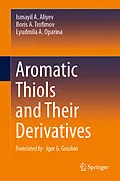This book is devoted to the synthetic and physical chemistry of aromatic thiols and their closest derivatives, sulfides, sulfoxides, sulfones, including those substituted by various functional groups such as acyl and thioacyl, alkoxide, ester, hydroxyl, and halogens. In some cases, for comparison, selenium and oxygen analogues are also detailed. The main focus of the book is on synthetic methods, both traditional and new, based on the use of transition metals as catalysts, as well as the reactivity of the compounds obtained. It addition the influence of conformational and electronic factors on spectral (NMR, IR, UV, NQR) and electrochemical characteristics of the compounds is presented. Finally the book describes the application of aromatic thiols and their derivatives as drug precursors, high-tech materials, building blocks for organic synthesis, analytical reagents and additives for oils and fuels. It is a useful handbook for all those interested in organosulfur chemistry.
Autorentext
Ismayil A. Aliyev is an organic chemist, a professor, D.Sc. (chemistry), the head of health and safety of life performance department and a professor of the department of organic chemistry Baku State University (Azerbaijan). His main research interests relate to chemistry and physical chemistry of aromatic sulfur derivatives, including new synthesis of pyrroles containing arylthio groups using acetylene, vinyl halides and 1, 2-dibromoalkanes in superbasic media. Also, he is engaged in the studies of relationship between physical-chemical properties of organosulfur compounds and their reactivity. He is the author of more than 270 publications, including 1 monograph, 5 textbooks, 3 manuals, 10 patents and 2 authors' certificates.
Boris A. Trofimov is an organic chemist, a full member of the Russian Academy of Sciences, a professor, D.Sc. (chemistry), the winner of the State Prize of the Russian Federation in the field of science and technology and a research supervisor at the A.E. Favorsky Irkutsk institute of chemistry SB RAS. Among his research interests are fine organic synthesis based on acetylene and its derivatives; superbase catalysts and reagents; chemistry of heterocyclic compounds (pyrroles, indoles, imidazoles, pyrazoles, furans, thiophenes, etc.) and the chemistry of organosulfur and phosphorus compounds. He is the author of 22 monographs and chapters in monographs, 62 reviews and more than 1000 main articles.
Ludmila A. Oparina is an organic chemist, Ph.D. (Chemistry), and a senior researcher at the A.E. Favorsky Irkutsk institute of chemistry SB RAS. Her main directions of research are acetylene chemistry, development of methods for the synthesis of vinyl ethers and sulfides in superbasic media. She is the author of more than 150 publications, authors' certificates and patents.
Klappentext
This book is devoted to the synthetic and physical chemistry of aromatic thiols and their closest derivatives, sulfides, sulfoxides, sulfones, including those substituted by various functional groups such as acyl and thioacyl, alkoxide, ester, hydroxyl, and halogens. In some cases, for comparison, selenium and oxygen analogues are also detailed. The main focus of the book is on synthetic methods, both traditional and new, based on the use of transition metals as catalysts, as well as the reactivity of the compounds obtained. It addition the influence of conformational and electronic factors on spectral (NMR, IR, UV, NQR) and electrochemical characteristics of the compounds is presented. Finally the book describes the application of aromatic thiols and their derivatives as drug precursors, high-tech materials, building blocks for organic synthesis, analytical reagents and additives for oils and fuels. It is a useful handbook for all those interested in organosulfur chemistry.
Inhalt
Introduction
Chapter 1. Synthesis of aromatic thiols
1.1. Reactions of aromatic thiols with elemental sulfur and its inorganic compounds
1.2. Reactions with other sulfur-containing nucleophiles
1.3. Reactions with sulfur-containing electrophiles
1.4. Reduction of diaryl disulfides
1.5. Examples of syntheses
1.5.1. Synthesis of 2- and 3-substituted aryl thiols from diazonium chlorides and potassium ethylxanthogenate
1.5.2. Synthesis of 4-substituted aryl thiols via reduction of aromatic sulfonyl chlorides
1.5.3. Synthesis of aryl thiols via reduction of diaryl disulfides
References
Chapter2. Aromatic sulfides
2.1. General approaches to synthesis of aryl sulfides
2.2. Catalytic methods of the C-S bond formation
2.3. Directed synthesis of substituted aromatic sulfides
2.3.1. Alkyl aryl sulfides
2.3.1.1. Alkylation of aryl thiols with primary and secondary alkyl halides
2.3.1.2. Other methods
2.3.2. tert-Alkyl aryl sulfides
2.3.3. Diaryl sulfides
2.3.4. Vinyl sulfides
2.3.5. Benzyl thiols and benzyl sulfides
2.3.6. Dialkyl sulfides
2.4. Examples of syntheses
2.4.1. Reactions of thiols with primary and secondary alkyl halides
2.4.2. Reactions of thiols with tertiary alkyl halides and alcohols
2.4.3. Reactions of thiols with alkenes
2.4.4. Reactions of thiols with acetylenes
2.4.5. Diaryl disulfides
2.4.6. Functionally substituted alkyl aryl sulfides
References
Chapter 3. Aromatic sulfoxides, sulfones and other derivatives of aromatic thiols
3.1. Aromatic sulfoxides
3.2. Aromatic sulfones3.3. alkyl benzyl sulfones
3.4. S-Alkyl, S-aryl, S-benzylthioacelates and organylthiobenzoates
3.5. 2-Arylthioethylacylates
3.6. Dithiocarboxylic acid dibenzyl esters
3.7. Derivatives of aromatic selenols
3.8. Examples of syntheses
3.8.1. Synthesis of aromatic sulfoxides
3.8.2. Alkyl aryl sulfones
3.8.3. Alkyl-, aryl-, and benzylthioacelates<...
